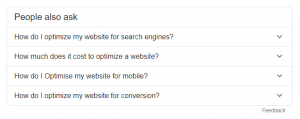You may have noticed the appearance of ‘People Also Ask’ panels in the Google search results over the past few months, where additional questions are added within the results, and include a drop down option to see one website result per question. As these are now showing for a wider range of search terms they can give search marketers another opportunity to target search rankings for specific questions.
 Google first introduced the People Also Ask (PAA) panel in 2015 but they have become more common and prominent this year, driven by Google’s algorithms to show these additional search options for terms that the system thinks require possible further expansion or clarification of the initial search query. The increased visibility of the PAA questions therefore presents an additional opportunity for websites to appear on the first page of the search results and for attracting a click to their content.
Google first introduced the People Also Ask (PAA) panel in 2015 but they have become more common and prominent this year, driven by Google’s algorithms to show these additional search options for terms that the system thinks require possible further expansion or clarification of the initial search query. The increased visibility of the PAA questions therefore presents an additional opportunity for websites to appear on the first page of the search results and for attracting a click to their content.
Initially there tends to be 4 PAA questions listed, and once one of the questions is clicked, the box expands to display a text snippet with a brief answer to the question, the source URL from where the text has been extracted and a shortcut link for performing another Google search for this particular question. You can sometimes see relevant videos from YouTube appear as the response to a question. In addition, every interaction with the PAA panels tends to add an additional two or three questions to the list.
Some recent research in the UK showed that almost half of search queries performed on Google now included a People Also Ask questions box. As we also reported recently, these results can also potentially stop a searcher going beyond the Google results if they can find the answer they need without clicking further to the site that has provided the information.
To take advantage of the PAA results, you firstly need to review the search terms that generate this type of content. For example, you can search for the common queries found in your Search Console or Google Ads reports to see if these generate a PAA panel, and then review the questions that are listed. This may then give you an indication of the questions being asked by searchers, or being presented with an answer by Google.
You then need to consider how to create new content, or optimise existing content to match these questions with the answer options. You do need to have an already optimised site that ranks well to get a chance of appearing in these results, but you also have to consider the following requirements to try to influence Google to show your content as an answer.
Firstly, you need to write some short, concise content that provides a complete answer to a listed question. It should be written simply, in non-sales language that provides the information relevant to the question, with the same wording and phrases. Secondly, you need to use the Q&A schema around your content – this needs some manual coding intervention, and you can read more about this here.
If you feel that you have, or can provide, content that answers one or more of the questions you can see appearing for common, high volume search terms relevant to your market, try implementing the above recommendations around the relevant page. If you can achieve this additional visibility it may help to drive more search traffic to your site.
For more information or help about optimising for the People Also Ask panels, please get in touch.
